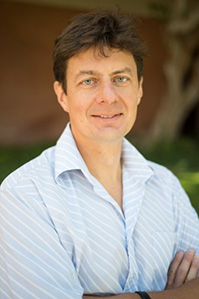| Quantum dots (QD) are quasi-zero dimensional structures with a unique combination of solid-state and atom-like properties.Unlike bulk or molecular materials, QD properties can be modified continuously by changing QD shape and size. Often, the bulk and molecular viewpoints contradict each other.QDs exhibit new physical phenomena. The phonon bottleneck to electron energy relaxation and generation of multipleexcitons can improve efficiencies of solar energy devices. The enhanced electron-hole interactions and high densities of states lead to a new electron transfer mechanism, Auger-assisted transfer, which eliminates the celebrated Marcus inverted regime and ensures consistently rapid charge separation. The observed QD properties are complicated by presence of ligands, dopants, defects and other chemical features. Our state-of-the-art non-adiabatic molecular dynamics techniques,implementedwithin time-dependent density-functional-theory, allow us to model QDs at the atomistic level and in time-domain,providing a unifying description of quantum dynamics on thenanoscale.
|
|  Oleg V. Prezhdo obtained a Diploma in Theoretical Chemistry in 1991 from Kharkiv National University, Ukraine, under Anatoly Luzanov. He completed his Ph.D. with Peter Rossky at the University of Texas, Austin. After a postdoctoral fellowship with John Tully at Yale University, he joined the chemistry department at the University of Washington in 1998, achieving Associate and Full Professor in 2002 and 2005. In 2008, he was elected Fellow of the American Physical Society. In 2010, he was offered a Senior Professorship at the University ofRochester, and in 2014 at the University of Southern California. Since 2008, he has served as editor for the Journal of Physical Chemistry, since 2011 for the Journal of Physical Chemistry Letters, and since 2012 for Progress in Surface Science. Recipient of multiple national and international awards, he held invited professorships in France, Germany, and Japan. His current research interests range from fundamental aspects of semiclassical physics, to excitation dynamics in nano-scale and biological systems. Oleg V. Prezhdo obtained a Diploma in Theoretical Chemistry in 1991 from Kharkiv National University, Ukraine, under Anatoly Luzanov. He completed his Ph.D. with Peter Rossky at the University of Texas, Austin. After a postdoctoral fellowship with John Tully at Yale University, he joined the chemistry department at the University of Washington in 1998, achieving Associate and Full Professor in 2002 and 2005. In 2008, he was elected Fellow of the American Physical Society. In 2010, he was offered a Senior Professorship at the University ofRochester, and in 2014 at the University of Southern California. Since 2008, he has served as editor for the Journal of Physical Chemistry, since 2011 for the Journal of Physical Chemistry Letters, and since 2012 for Progress in Surface Science. Recipient of multiple national and international awards, he held invited professorships in France, Germany, and Japan. His current research interests range from fundamental aspects of semiclassical physics, to excitation dynamics in nano-scale and biological systems.
|
